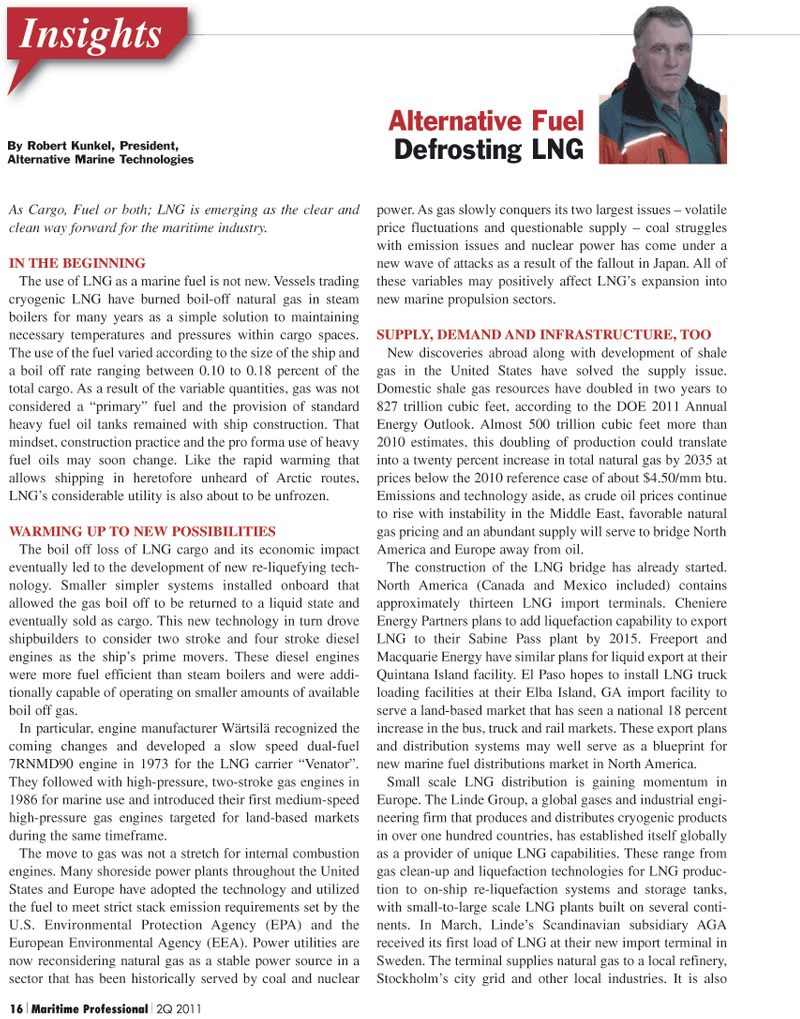
Page 16: of Maritime Logistics Professional Magazine (Q2 2011)
Energy Transportation
Read this page in Pdf, Flash or Html5 edition of Q2 2011 Maritime Logistics Professional Magazine
16 Maritime Professional 2Q 2011
As Cargo, Fuel or both; LNG is emerging as the clear and clean way forward for the maritime industry.
IN THE BEGINNING
The use of LNG as a marine fuel is not new. Vessels trading cryogenic LNG have burned boil-off natural gas in steam boilers for many years as a simple solution to maintaining necessary temperatures and pressures within cargo spaces.
The use of the fuel varied according to the size of the ship and a boil off rate ranging between 0.10 to 0.18 percent of the total cargo. As a result of the variable quantities, gas was not considered a “primary” fuel and the provision of standard heavy fuel oil tanks remained with ship construction. That mindset, construction practice and the pro forma use of heavy fuel oils may soon change. Like the rapid warming that allows shipping in heretofore unheard of Arctic routes,
LNG’s considerable utility is also about to be unfrozen.
WARMING UP TO NEW POSSIBILITIES
The boil off loss of LNG cargo and its economic impact eventually led to the development of new re-liquefying tech- nology. Smaller simpler systems installed onboard that allowed the gas boil off to be returned to a liquid state and eventually sold as cargo. This new technology in turn drove shipbuilders to consider two stroke and four stroke diesel engines as the ship’s prime movers. These diesel engines were more fuel efficient than steam boilers and were addi- tionally capable of operating on smaller amounts of available boil off gas.
In particular, engine manufacturer Wärtsilä recognized the coming changes and developed a slow speed dual-fuel 7RNMD90 engine in 1973 for the LNG carrier “Venator”.
They followed with high-pressure, two-stroke gas engines in 1986 for marine use and introduced their first medium-speed high-pressure gas engines targeted for land-based markets during the same timeframe.
The move to gas was not a stretch for internal combustion engines. Many shoreside power plants throughout the United
States and Europe have adopted the technology and utilized the fuel to meet strict stack emission requirements set by the
U.S. Environmental Protection Agency (EPA) and the
European Environmental Agency (EEA). Power utilities are now reconsidering natural gas as a stable power source in a sector that has been historically served by coal and nuclear power. As gas slowly conquers its two largest issues – volatile price fluctuations and questionable supply – coal struggles with emission issues and nuclear power has come under a new wave of attacks as a result of the fallout in Japan. All of these variables may positively affect LNG’s expansion into new marine propulsion sectors.
SUPPLY, DEMAND AND INFRASTRUCTURE, TOO
New discoveries abroad along with development of shale gas in the United States have solved the supply issue.
Domestic shale gas resources have doubled in two years to 827 trillion cubic feet, according to the DOE 2011 Annual
Energy Outlook. Almost 500 trillion cubic feet more than 2010 estimates, this doubling of production could translate into a twenty percent increase in total natural gas by 2035 at prices below the 2010 reference case of about $4.50/mm btu.
Emissions and technology aside, as crude oil prices continue to rise with instability in the Middle East, favorable natural gas pricing and an abundant supply will serve to bridge North
America and Europe away from oil.
The construction of the LNG bridge has already started.
North America (Canada and Mexico included) contains approximately thirteen LNG import terminals. Cheniere
Energy Partners plans to add liquefaction capability to export
LNG to their Sabine Pass plant by 2015. Freeport and
Macquarie Energy have similar plans for liquid export at their
Quintana Island facility. El Paso hopes to install LNG truck loading facilities at their Elba Island, GA import facility to serve a land-based market that has seen a national 18 percent increase in the bus, truck and rail markets. These export plans and distribution systems may well serve as a blueprint for new marine fuel distributions market in North America.
Small scale LNG distribution is gaining momentum in
Europe. The Linde Group, a global gases and industrial engi- neering firm that produces and distributes cryogenic products in over one hundred countries, has established itself globally as a provider of unique LNG capabilities. These range from gas clean-up and liquefaction technologies for LNG produc- tion to on-ship re-liquefaction systems and storage tanks, with small-to-large scale LNG plants built on several conti- nents. In March, Linde’s Scandinavian subsidiary AGA received its first load of LNG at their new import terminal in
Sweden. The terminal supplies natural gas to a local refinery,
Stockholm’s city grid and other local industries. It is also
Insights
Alternative Fuel
Defrosting LNG
By Robert Kunkel, President,
Alternative Marine Technologies

 15
15

 17
17
